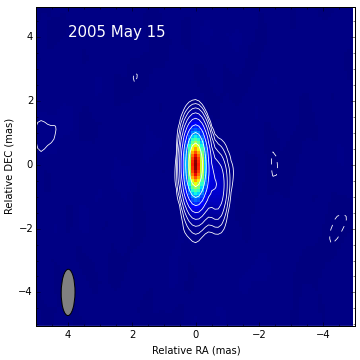|
|
| Revealing radio structure of a quasar shinning in the early universe with high-resolution VLBI images |
 |
Text Size: A A A |
|
High-redshift quasars (HRQs) are important for cosmology and galaxy studies as they can provide information of accretion processes on supermassive black holes (SMBH) and AGN evolution in the early Universe. Among the HRQs, the radio-loud subsample constitutes an attractive group since the radio jets are directly related to the SMBH activity. Their radio structures can be studied with the highest-angular resolution on milli-arcsecond scales via Very Long Baseline Interferometry (VLBI) technique. Until now, more 100 quasars have been detected at z > 5 while the number of radio-loud ones is about 10. Recently, an international science team led by Prof. AN Tao from Shanghai Astronomical Observatory (SHAO) has studied radio-loud HRQs, and found one promising target CGRaBS J0906+6930 (hereafter J0906+6930) in the early Universe. This work has been accepted for publication by Monthly Notices of the Royal Astronomical Society. J0906+6930 was discovered as the most distant radio blazar at that time in 2004, with a redshift of z=5.47. The radio flux of J0906+6930 at 15 GHz is over 100 mJy which makes it the best candidate for VLBI imaging at z> 5. In order to verify its physical nature, AN Tao' s group has conducted a new VLBI observation using the KVN and VERA Array (KaVA) in 2016 January which led to obtaining a compact source image with the flux density of 80 mJy at 22 GHz. This observation was served as the first application of KaVA for imaging studies of high-z quasars. 
Fig.1 The re-analyzed image of J0906+6930 from VLBA database at 15 GHz. "By collecting and analyzing previous VLBI data of J0906+6930, we investigate the detected variability, compact core-jet structure and high flux density. All these evidence confirms its nature as a balzar," said by the first author ZHANG Yingkang, a first-grade PhD student in the group, "A peaked spectrum around 10 GHz is found, which suggest that the source could be a newly born quasar in the early universe." 
Fig.2 Radio spectrum of J0906+6930. The data points are from these and previous Interferometric observations. Prof. AN Tao, the PI of this research project, said, "the evolution of SMBHs in early stages of the Universe has been a hot topic in astrophysics frontier for a long time. The detection of z > 5 radio-loud quasars demonstrates that SMBHs have already existed just after the Epoch of Reionization and were producing prominent electromagnetic radiation. The high radio flux density and compact core-jet structure makes J0906+6930 an excellent laboratory for studying radio activity of AGN at the youngest age of the Universe." The group is now planning for follow-up high-resolution VLBI observations of this target, aiming at studying spectrum evolution and jet proper motion. The unique radio properties of J0906+6930 will surely provide more valuable information about the baby Universe. Link to the research paper: https://arxiv.org/abs/1702.03925 Science Contacts: AN Tao, Shanghai Astronomical Observatory, antao@shao.ac.cn ZHANG Yingkang, Shanghai Astronomical Observatory, ykzhang@shao.ac.cn News Contact: ZUO Wenwen, Shanghai Astronomical Observatory, wenwenzuo@shao.ac.cn |
|